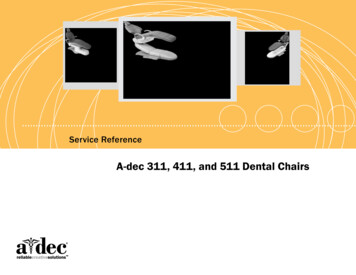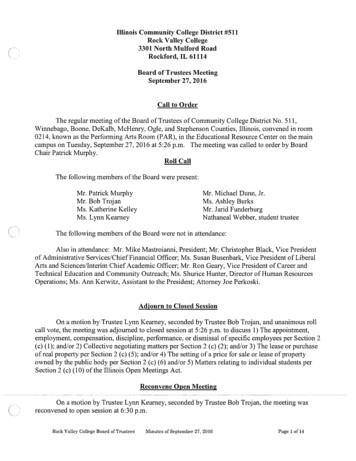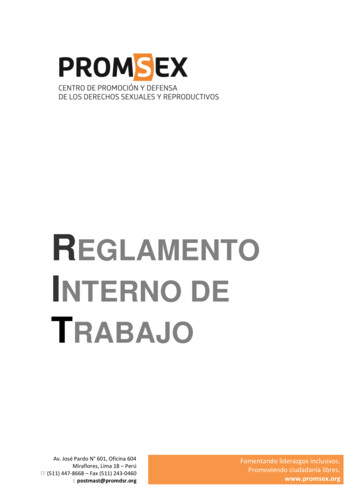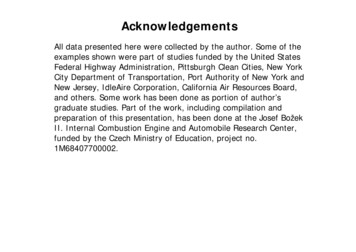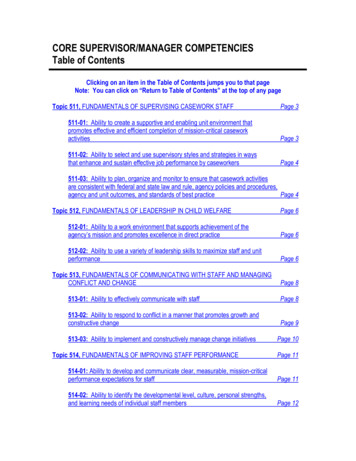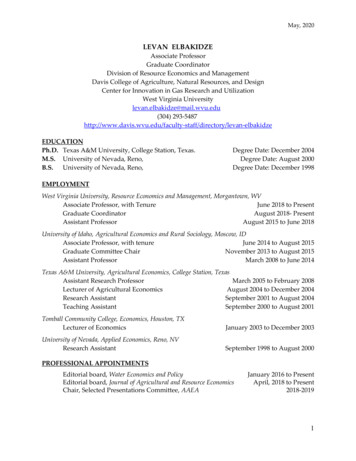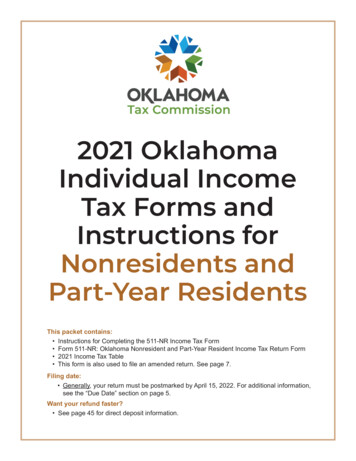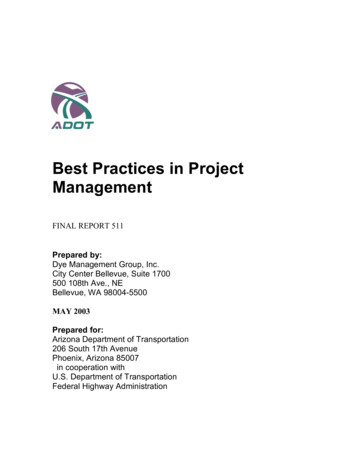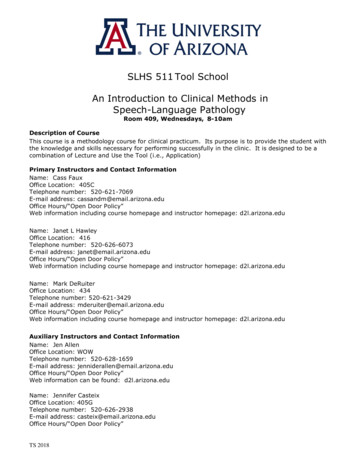
Transcription
SLHS 511 Tool SchoolAn Introduction to Clinical Methods inSpeech-Language PathologyRoom 409, Wednesdays, 8-10amDescription of CourseThis course is a methodology course for clinical practicum. Its purpose is to provide the student withthe knowledge and skills necessary for performing successfully in the clinic. It is designed to be acombination of Lecture and Use the Tool (i.e., Application)Primary Instructors and Contact InformationName: Cass FauxOffice Location: 405CTelephone number: 520-621-7069E-mail address: cassandm@email.arizona.eduOffice Hours/“Open Door Policy”Web information including course homepage and instructor homepage: d2l.arizona.eduName: Janet L HawleyOffice Location: 416Telephone number: 520-626-6073E-mail address: janet@email.arizona.eduOffice Hours/“Open Door Policy”Web information including course homepage and instructor homepage: d2l.arizona.eduName: Mark DeRuiterOffice Location: 434Telephone number: 520-621-3429E-mail address: mderuiter@email.arizona.eduOffice Hours/“Open Door Policy”Web information including course homepage and instructor homepage: d2l.arizona.eduAuxiliary Instructors and Contact InformationName: Jen AllenOffice Location: WOWTelephone number: 520-628-1659E-mail address: jenniderallen@email.arizona.eduOffice Hours/“Open Door Policy”Web information can be found: d2l.arizona.eduName: Jennifer CasteixOffice Location: 405GTelephone number: 520-626-2938E-mail address: casteix@email.arizona.eduOffice Hours/“Open Door Policy”TS 2018
Web information can be found: d2l.arizona.eduName: Kathleen CazzatoOffice Location: 418Telephone number: 520-621-2527E-mail address: kcazzato@email.arizona.eduOffice Hours/“Open Door Policy”Web information can be found: d2l.arizona.eduName: Lea CuznerOffice Location: Wings on Words Preschool 202 E. Speedway Blvd.Telephone number: (520) 628-1659E-mail address: lcuzner@email.arizona.eduOffice Hours: "Open Door Policy"Web information can be found: d2l.arizona.eduName: Rui MotoyoshiOffice Location: 414Telephone number: 520-621-2527E-mail address: ruimotoyoshi@email.arizona.eduOffice Hours/“Open Door Policy”Web information can be found: d2l.arizona.eduCourse Format and Teaching MethodsLecture, small-group activities, experiential-learning, in-class discussionCourse Objectives and Expected Learning OutcomesCourse Objectives:The student will learn and understand the clinical process by being able to:1. write a treatment plan that includes a long-term goal, behavioral objective with a personcentered focus on function;2. demonstrate various data collection methods;3. structure and generate a well-written “background summary”;4. write daily notes in SOAP format within Lytec;5. modify and manage existing behavior, teach new skills, or promote compensation;6. write and execute a lesson plan including the session objective, therapy techniques, andactivities;7. demonstrate various treatment techniques for pediatric and adult populations.Absence and Class Participation PolicyThe UA’s policy concerning Class Attendance, Participation, and Administrative Drops is availableat: -participation-and-administrative-dropThe UA policy regarding absences for any sincerely held religious belief, observance or practicewill be accommodated where reasonable, saccommodation-policy.Absences pre-approved by the UA Dean of Students (or Dean Designee) will be honored. ticipating in the course and attending lectures and other course events are vital to thelearning process. As such, attendance is required at all lectures and discussion section meetings.Students who miss class due to illness or emergency are required to bring documentation from2TS 2018
their health-care provider or other relevant, professional third parties. Failure to submit thirdparty documentation will result in unexcused absences.Course CommunicationsOnline communication will be conducted by official UA e-mail address and D2LReadingsRequired power points and readings can be accessed via D2LTREATMENT ech-Language-Pathologists/Dwight, D.D. (2006). Here’s how to do therapy. Plural Publishing, Inc. San Diego, CA, Chapter 5Structuring Therapy PPT (d2l.arizona.edu)GOALS AND OBJECTIVESBurrus, A. Embry, Willis, Laura B. (2017). Professional communication in speech-language pathology: How to write, talk,and act like a clinician (3rd ed). San Diego, CA: Plural Publishing, Inc. Chapter 6Goals and Objectives PPT (d2l.arizona.edu)EVIDENCE-BASED PRACTICE & ence-Based-Practice/Measuremania PPT (see d2l.arizona.edu)SOAPBurrus, A. Embry, Willis, Laura B. (2017). Professional communication in speech-language pathology: How to write, talk,and act like a clinician (3rd ed). San Diego, CA: Plural Publishing, Inc. Chapter7SOAP PPT (d2l.arizona.edu)MANAGING BEHAVIORRuff, M.B et al.,(1998). Positive behavioral support, strategies for teachers. Intervention for School and Clinic.1; 34; 21-32.ORAL MECHANISM/MOTOR SPEECHSt. Louis, K.O., Ruscello, D.M. (2000). Oral Speech Mechanism Screening Examination-Third Edition, manual pp. 1-39 Austin,Tx Pro-EdOME PPT (d2l.arizona.edu)REPORT WRITINGGoldfarb, R. and Serpanos, Y.C. (2009). Professional Writing in Speech-Language Pathology and Audiology. Chapter 1 (1-36)San Diego, Plural Publishing.Common Peccadillos & Proofing and Practice PPT (d2l.arizona.edu)Resources/References (optional):Optional texts can be purchased through the UA BookstoresRoth, Froma P, Worthington, Colleen K. (2018). Treatment resource manual for speech language pathology (5th ed). SanDiego, CA: Plural Publishing, Inc.Paul, Rhea. (2014). Introduction to clinical methods in communication disorders (3rd ed). Baltimore, MD: Paul H. BrookesPublishing Co.Burrus, A. Embry, Willis, Laura B. (2017). Professional communication in speech-language pathology: How to write, talk,and act like a clinician (3rd ed). San Diego, CA: Plural Publishing, Inc.Assignments and Examinations: Schedule/Due DatesAssignmentPerson-CenteredFunctional Goaland ss/Outsideof ClassIn-Class ActivityDue DateTotal Points8/27/1810 pointsOutside of ClassIn-Class Activities8/29/18Each ClassOutside of Class9/24/18 (turn into clinicalinstructor)3 points32 points (2points/activity)10 points3TS 2018
Demonstration ofTherapyTechniquesSelf-Analysis ofTreatmentSessionIn-Class Activity9/19 & 10/310 points totalOutside of ClassWeek ofNovember 12,201835 points(serves as yourfinalexamination)100 pointsTotalAssignment Format and Rubrics (outside of class assignments) Interview your client/caregiver and write a Background Summary. This summary will gointo your Progress Report. Interviewing styles and format for the Background Summary willbe discussed in Tool School. Background Summary will be graded by your clinical instructor.Components:Content: 4 points;Organization: 1 point;Use of correct tense: 1 point;Grammar and Spelling: 2 points;Timeliness: 2 points. Self-Analysis of Treatment Session will be completed outside of class during the week of11/12/18 (35 points). You will be graded by your clinical instructor.Select a 5 minute video of an individual treatment session and present an oralreflection during your individual meeting with your clinical instructor.Your reflection should include the following components:Components: Structuring Therapy: 5 points Target Objective (s): 5 points Lesson Plan: 5 points Evidence-Based Practice and Intervention: 5 points Data Collection: 5 points Managing Behavior: 5 points Professional Communication: 5 pointsYour grade will be based on the quality of your analysis and inclusion of the notedcomponents, and not on the quality of the therapy session.4TS 2018
Rubric:Components StructuringTherapy TargetObjective Lesson Plan EBP andIntervention Data Collection ManagingBehavior ProfessionalCommunicationPointsExcellentComponent ent isdiscussedsufficiently; althoughthe information isnot expansive ordetailedPoorComponent isinsufficientlyaddressed orreflects alimited grasp ofthe key features5 each3 each1 eachTotal points: 35 pointsFinal Examination or ProjectThe Self-Analysis assignment will serve as your final examination for the course.Grading Scale90-100 points A; 80-89 B; 70-79 CRequests for incomplete (I) or withdrawal (W) must be made in accordance with Universitypolicies, which are available at ngsystem#incomplete and ng-system#WithdrawalrespectivelyScheduled Topics/ActivitiesUnit 1: Logistics [clinic tour, clinic resources (e.g., Lytec, Encounter forms, Clinic Manual, ASHAstandards, ASHA code of Ethics, ASHA Portal)]Unit 2: Getting to know your Client (interviewing, communication sampling procedures, datacollection)Unit 3: Establishing Objectives (goals and objectives, writing SOAP notes)Unit 4: Treatment techniques [structuring therapy, communication intervention principles andprocedures (clinician directed and client centered), behavior management, reinforcement, feedback,proxemics, lesson plan]Unit 5: Professional Communication (progress reports, counseling, ethics)Unit 6: Related Topics (oral mechanism examination, and hearing screenings)Unit 7: Using Technology in the Clinics5TS 2018
DateTopicAssignmentAugust 20Orientation to Tool SchoolReview:Clinic Manual/HIPAA Guide; (slhsfac and d2l)Bloodborne Pathogens(uaccess)How-To:Lytec (d2l)Lytec Assignment dueAugust 29In-class activities8-12pmUnit 1IntroductionsD2L (558 & 511)Clinic Manual (slhsfac.arizona.edu & d2l)(Seek and Speak)Clinic FormsLytecClinic Tour (11-12pm)Second-Year MS StudentsAugust 22Communication Sampling Procedures for Adultand Pediatric populationsCommunication SamplingUnit 2Communication SamplingpptData CollectionData CollectionpptIn-class activityAugust 27Unit 3August 29Goals & Objectives: BehavioralPerson-Centered Functional GoalsSMARTGoal AttainmentSOAP notesClinic assignments will bedistributed outside of classGoals and ObjectivespptReadingBurrus, CH 6 (d2l)In-class activitySOAPpptIn-class activityReadingBurrus, Ch 7 (d2l)Unit 3Lytec Assignment Due6TS 2018
Sept 5Unit 2 & 5Interviewing[taking a Case History/Demographics andBackground History (this information will go inyour progress report)]Professional Communication and CounsellingWeek ofSept 3Start-up in clinic (Mentorship as ClinicianAssistant Helpers (MaTCH) program beginsSept 12EBPUnit 4Treatment Techniques 1September19Clinic Staff (Q & A)Feday BarakatPatricia SanchezJulieta CalderonJoanie LefflerUnit 1 & 4Interviewingpptin-class activityBackground Summaries due9/24 to clinical instructorsTreatment Techniques 1pptReadingDwight, Ch 5 (d2l)Please see Roth & Worthingtonfor specific therapy techniquesTreatment Techniques 2pptIn-class activityTreatment Techniques 2Sept 24No ClassBackground summaries dueSeptember26Writing Progress ReportsClinical DocumentationpptIn-class activityUnit 5(mid-semester non-Medicare reports due 10/11to clinical instructor)October 3Treatment Techniques 3Treatment Techniques 3ppt7TS 2018
Unit 4October 10Instrumentation (SPL, Visipitch, ChatterVox,Nasometer; Video)Unit 7October 17Introduction to Behavior ManagementUnit 4October 24Oral Mechanism ExaminationUnit 6Meghan Darling-White, PhD, CCC-SLPOctober 31Hands-on/Use the Toolmid-semester non-Medicarereports due 10/11 toclinical instructorIn-class discussion based onreading: Ruff et al., 1998.Positive behavioral support(d2l)OMEPptEthicsHands-onEthicspptUnit 5Professionalism in on- and off-campusplacements (discussion)November 7Conducting Hearing ScreeningsFadyeh Barakat, AuD, CCC-A-CRCLinda Norrix, PhD, CCC-AAudiology StudentsHearing ScreeningspptTBDSelf-Analysis of TreatmentSession Due week of Nov 12(during meeting withclinical instructor)Unit 6November14Unit 6November21In-class discussionIn-class activityTBD8TS 2018
Classroom Behavior PolicyTo foster a positive learning environment, students and instructors have a shared responsibility.We want a safe, welcoming, and inclusive environment where all of us feel comfortable with eachother and where we can challenge ourselves to succeed. To that end, our focus is on the tasks athand and not on extraneous activities (e.g., texting, chatting, reading a newspaper, makingphone calls, web surfing, etc.).Threatening Behavior PolicyThe UA Threatening Behavior by Students Policy prohibits threats of physical harm to anymember of the University community, including to oneself. ty and AccommodationsAt the University of Arizona we strive to make learning experiences as accessible as possible. Ifyou anticipate or experience physical or academic barriers based on disability or pregnancy, youare welcome to let me know so that we can discuss options. You are also encouraged to contactDisability Resources (520-621-3268) to explore reasonable accommodation.If our class meets at a campus location: Please be aware that the accessible table and chairs inthis room should remain available for students who find that standard classroom seating is notusable.Code of Academic IntegrityStudents are encouraged to share intellectual views and discuss freely the principles andapplications of course materials. However, graded work/exercises must be the product ofindependent effort unless otherwise instructed. Students are expected to adhere to the UA Codeof Academic Integrity as described in the UA General Catalog. egrity/students/academic-integrity.TheUniversity Libraries have some excellent tips for avoiding plagiarism, available lagiarism.Selling class notes and/or other coursematerials to other students or to a third party for resale is not permitted without the instructor’sexpress written consent. Violations to this and other course rules are subject to the Code ofAcademic Integrity and may result in course sanctions. Additionally, students who use D2L or UAe-mail to sell or buy these copyrighted materials are subject to Code of Conduct Violations formisuse of student e-mail addresses. This conduct may also constitute copyright infringement.UA Nondiscrimination and Anti-harassment PolicyThe University is committed to creating and maintaining an environment free of discrimination;see imination-and-anti-harassmentpolicyOur classroom is a place where everyone is encouraged to express well-formed opinionsand their reasons for those opinions. We also want to create a tolerant and open environmentwhere such opinions can be expressed without resorting to bullying or discrimination of others.Additional Resources for StudentsUA Academic policies and procedures are available at http://catalog.arizona.edu/policiesStudent Assistance and Advocacy information is available ance/students/student-assistanceConfidentiality of Student t-1974-ferpa?topic ferpaSubject to Change StatementInformation contained in the course syllabus, other than the grade and absence policy, may be9TS 2018
subject to change with advance notice, as deemed appropriate by the instructor.10TS 2018
4. write daily notes in SOAP format within Lytec; 5. modify and manage existing behavior, teach new skills, or promote compensation; 6. write and execute a lesson plan including the session objective, therapy techniques, and activities; 7. demonstrate various treatment techniques for pediatric and adult populations.
